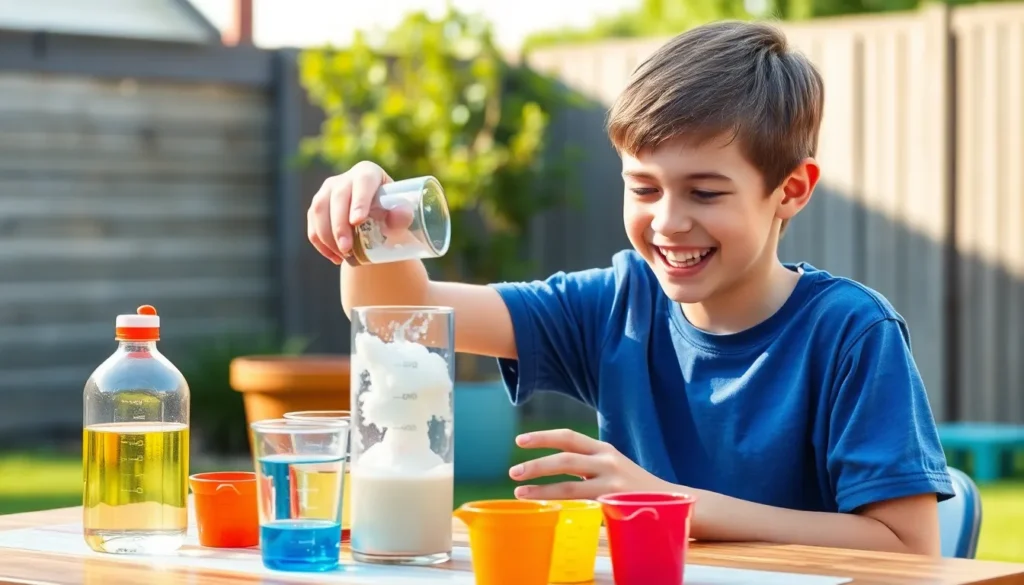Table of Contents
ToggleHomeschooling offers a unique opportunity to blend education with hands-on learning, and science experiments are a perfect way to ignite curiosity. These experiments not only make complex concepts accessible but also encourage critical thinking and problem-solving skills. Parents and students can explore the wonders of science together, transforming the kitchen or backyard into a vibrant lab.
From simple chemical reactions to fascinating physics demonstrations, homeschool science experiments can cater to various age groups and interests. They provide an engaging way to reinforce lessons while fostering a love for discovery. Dive into the world of science at home, where each experiment serves as a stepping stone to greater understanding and inspiration for future learning adventures.
Overview of Homeschool Science Experiments
Homeschool science experiments offer a hands-on approach to learning, making intricate scientific principles accessible and engaging. These activities promote critical thinking and problem-solving skills, allowing students to apply theoretical knowledge in practical situations. Using everyday spaces like kitchens and backyards as makeshift labs encourages creativity and resourcefulness.
Parents and students can explore a diverse range of experiments that cater to various age groups and interests. Popular experiments include creating chemical reactions with household items, developing simple circuits with batteries and wires, and growing crystals using sugar or salt. These activities not only reinforce educational lessons but also inspire a lifelong curiosity for science.
By fostering collaboration between parents and children, homeschool science experiments enhance the learning experience. Structured projects can easily integrate topics from biology, chemistry, and physics, making the learning process both comprehensive and enjoyable. Engaging in these experiments cultivates a shared appreciation for scientific discovery, encouraging deeper exploration of the natural world.
Benefits of Conducting Homeschool Science Experiments

Homeschool science experiments provide a practical way to deepen understanding and spark interest in scientific concepts. These hands-on activities enhance both educational engagement and critical skills.
Enhancing Learning Engagement
Engagement flourishes through hands-on science experiments. Students experience direct interaction with materials, making abstract concepts tangible. This active participation leads to better retention of information. For example, exploring plant growth through seed germination fosters curiosity and encourages observation. The integration of familiar settings, such as kitchens or gardens, makes learning relevant and exciting. Additionally, experiments cater to various learning styles, ensuring that visual, auditory, and kinesthetic learners benefit equally.
Fostering Critical Thinking Skills
Critical thinking skills develop significantly during homeschool science experiments. Students pose questions, formulate hypotheses, and analyze results, promoting analytical thinking. When students encounter unexpected outcomes, they practice troubleshooting, enhancing problem-solving abilities. For instance, modifying variables in a chemical reaction leads to discussions on cause and effect. Engaging in this iterative process encourages a scientific mindset, where experimentation and inquiry become central to learning. This exposure not only equips students with essential life skills but also lays a foundation for future academic success.
Types of Homeschool Science Experiments
Homeschool science experiments vary significantly in complexity, catering to beginners and more experienced learners. Parents can select activities based on age and skill level, ensuring a suitable challenge for their child.
Simple Experiments for Beginners
Simple experiments engage younger students and introduce fundamental concepts. These experiments often utilize household items, ensuring accessibility and ease of execution. Examples include:
- Vinegar and Baking Soda Reaction: Combining vinegar with baking soda produces a fizzy reaction, demonstrating acid-base interactions.
- Balloon Rockets: Attaching a balloon to a straw on a string shows basic principles of motion and propulsion when the balloon deflates.
- Plant Growth: Planting seeds in different conditions (light versus dark) illustrates how environmental factors affect growth.
These experiments foster curiosity and encourage children to ask questions about the science behind the reactions.
Advanced Experiments for Experienced Students
Advanced experiments challenge older students and promote deeper understanding of scientific principles. These activities encourage critical thinking and experimentation, making them ideal for more seasoned learners. Examples include:
- Electrolysis of Water: Dividing water into hydrogen and oxygen gas using electricity demonstrates chemical reactions and energy transformation.
- Homemade Lava Lamp: Combining oil, water, and food coloring with Alka-Seltzer tablets creates a visual display of density and chemical reaction.
- Solar Oven: Constructing a solar oven from cardboard and aluminum foil teaches principles of energy transfer and renewable resources.
These experiments stimulate analytical skills and inspire students to explore further scientific inquiries.
Resources for Homeschool Science Experiments
A wealth of resources exists to support homeschool science experiments, making learning both accessible and enjoyable. These resources include recommended books, online platforms, and communities that offer valuable information and inspiration.
Recommended Books and Guides
- “The Science Book” by DK: This visual guide presents scientific concepts in a clear, engaging manner, suitable for various age groups.
- “The Everything Kids’ Science Experiments Book” by Tom Robinson: It provides easy-to-follow experiments that use common household items, encouraging hands-on learning.
- “100 Science Experiments for Kids” by Vicki Stoecklin: This collection includes diverse activities covering chemistry, physics, and biology, promoting curiosity and exploration.
- “Home Learning Year by Year” by Rebecca Rupp: It offers a complete guide to homeschooling and includes science-related activities within curriculum suggestions.
- “Science Experiments You Can Eat” by Angela R. Kauffman: This book focuses on edible experiments, appealing to younger learners while teaching scientific concepts through food.
Online Platforms and Communities
- American Association of Physics Teachers (AAPT): Offers resources, experiments, and curriculum guides for physics education tailored for various learning levels.
- NASA’s Jet Propulsion Laboratory (JPL): Provides hands-on activities and downloadable resources, including fascinating science projects.
- Science Buddies: A website with experiment ideas and project guidance across various topics, aiding families in selecting age-appropriate activities.
- Facebook Groups: Communities such as “Homeschool Science” and “Hands-On Science for Homeschoolers” create a platform for sharing resources, experiences, and experiment ideas.
- YouTube Channels: Channels like “Steve Spangler Science” and “The Crazy Scientist” feature engaging science experiments and demonstrations, offering visual guidance for at-home learners.
These resources enrich the homeschooling experience by fostering creativity, collaboration, and a profound understanding of scientific principles.
Tips for Successful Homeschool Science Experiments
- Plan Ahead
Prepare all materials and experiment steps in advance. Having everything ready minimizes confusion and maximizes focus during the activity.
- Choose Age-Appropriate Experiments
Select experiments that match the child’s age and skill level. Younger students benefit from simple tasks, while older students can tackle more complex projects.
- Create a Safe Environment
Ensure the workspace is safe and organized. Use protective gear, such as goggles and gloves, when necessary, to avoid accidents during experiments.
- Encourage Exploration
Foster curiosity by allowing children to ask questions and explore beyond the experiment’s parameters. This stimulates critical thinking and deeper understanding.
- Document Findings
Keep a science journal to record observations and results. Documenting findings enhances retention and provides a reference for future experiments.
- Incorporate Technology
Use online resources for guidance and inspiration. Websites and videos can offer step-by-step instructions and insights into scientific concepts.
- Make It Interactive
Involve children in discussions about the scientific principles at play. Engaging them in conversation promotes better comprehension and interest in the subject.
- Connect to Real-Life Applications
Relate experiments to daily life to illustrate relevance. Showing how science applies to everyday situations helps children understand the importance of their studies.
- Be Patient and Flexible
Embrace the learning process, including mistakes and unexpected results. Flexibility allows adjustments to experiments, fostering resilience in scientific inquiry.
- Celebrate Successes
Recognize and celebrate the achievements, big or small. Positive reinforcement encourages enthusiasm for learning and builds confidence in scientific abilities.
Homeschool science experiments offer an invaluable opportunity for families to engage in hands-on learning. By transforming everyday spaces into laboratories, parents and children can explore scientific concepts together. This approach not only enhances understanding but also fosters a love for discovery and inquiry.
With a variety of experiments available for all ages and skill levels, there’s no shortage of ways to spark curiosity. Whether it’s a simple reaction in the kitchen or a more complex project in the backyard, these activities promote collaboration and critical thinking.
Ultimately, the joy of scientific exploration lies in the shared experiences and discoveries made along the way. Embracing these experiments can inspire a lifelong passion for science and learning.







